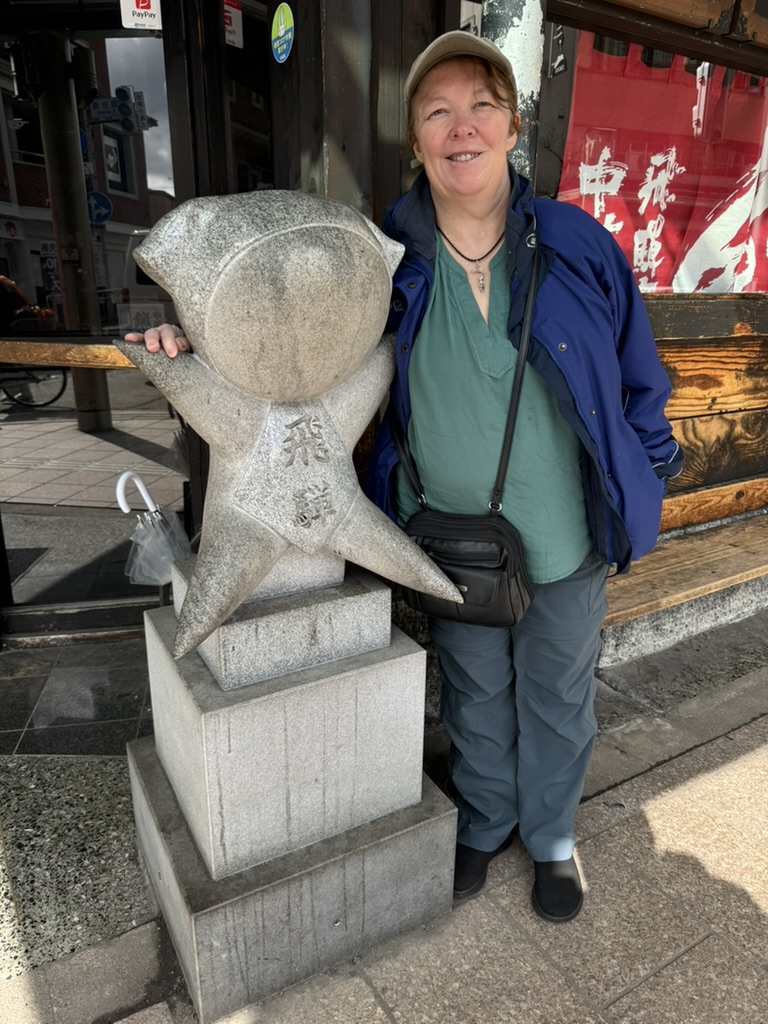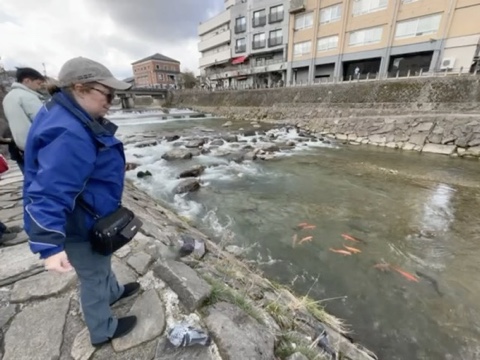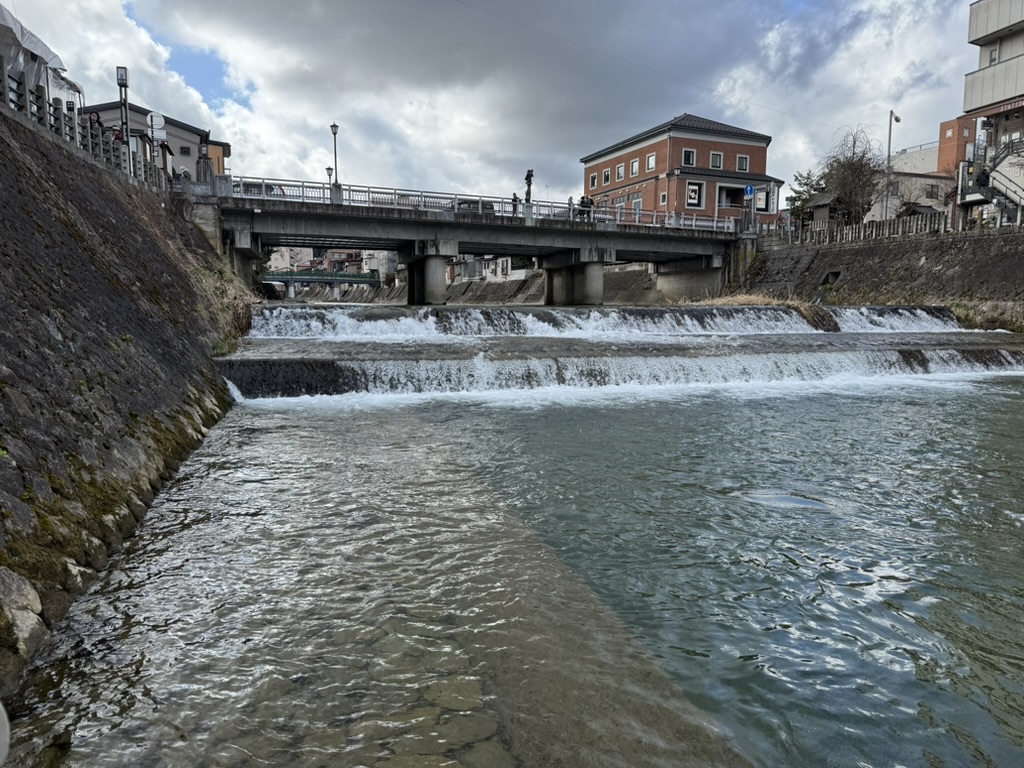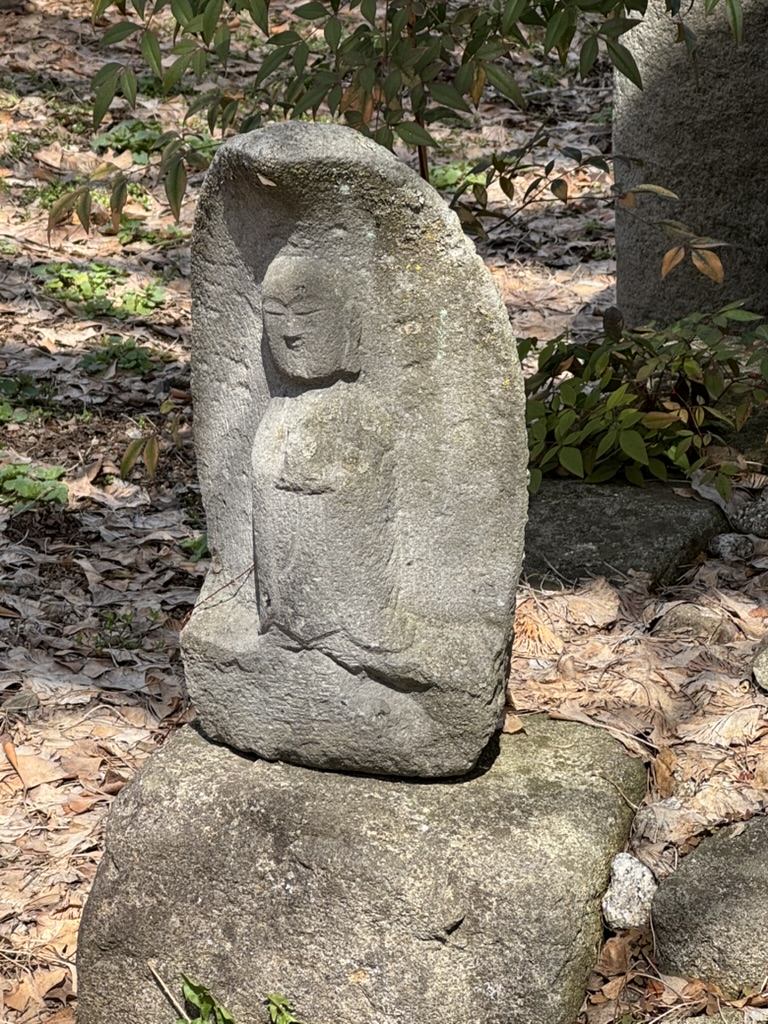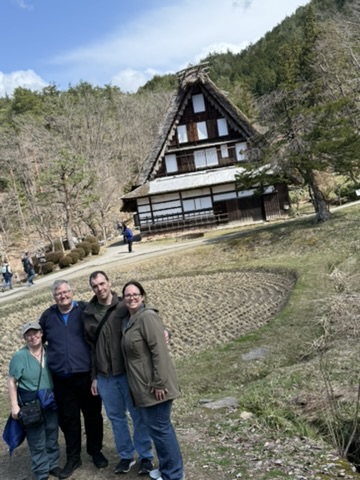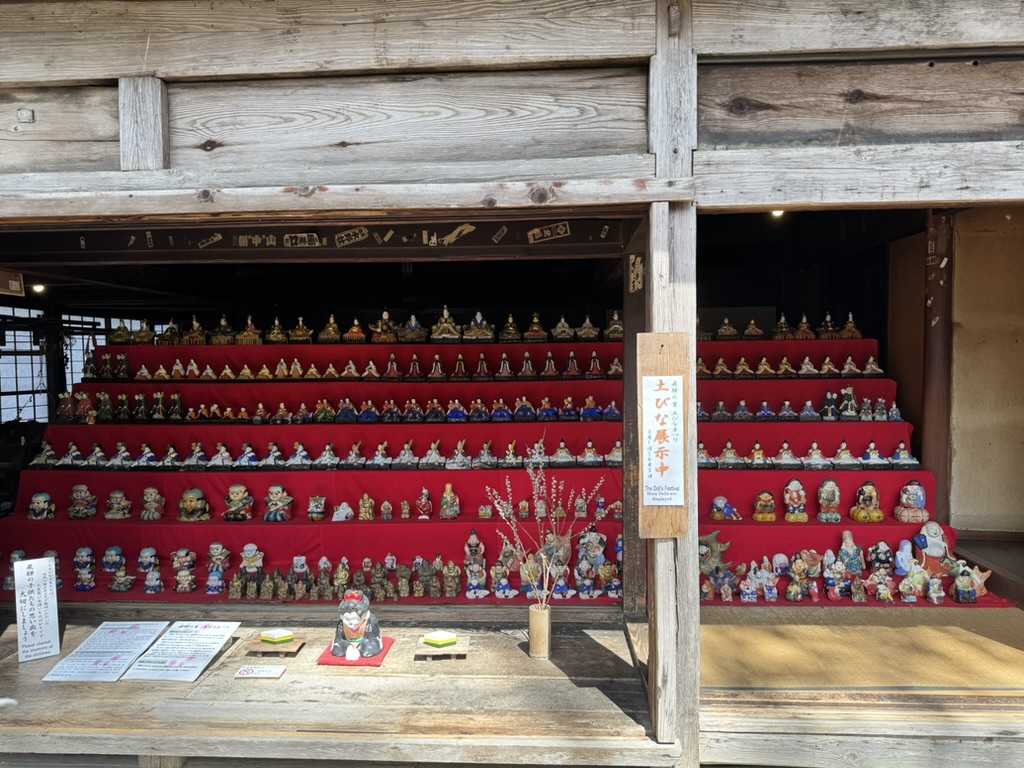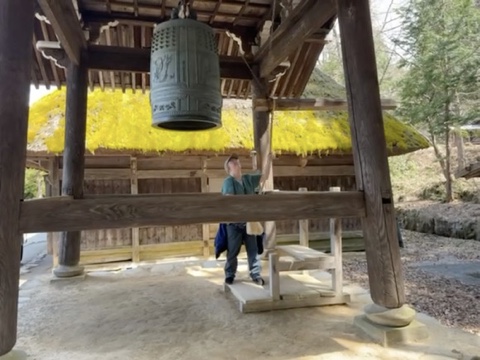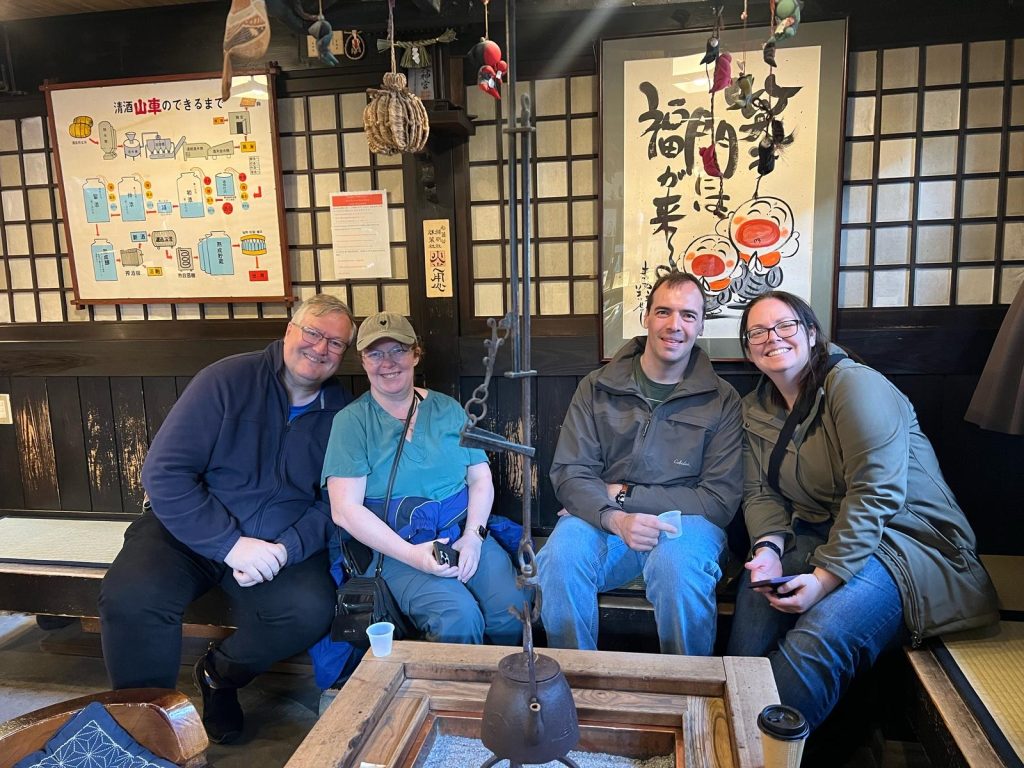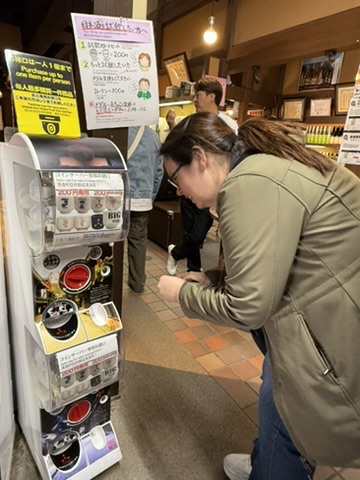
So it’s our second day in Takayama, and again we got up a bit early. I think Teresa wanted to experience that teakwood tub again, and I don’t blame her. She once again left it for me, and I took advantage of the size as I floated in the hot water. We got dressed and headed down for breakfast. We sat down, and our plates were put in front of us quite quickly. The food was good and a great way to start the morning. We headed back upstairs after breakfast, packed our bags, and checked out.
We walked a couple of blocks to our next hotel. You might be wondering why we booked two hotels in the same city. This marked the halfway point of our Japanese tour. While we found many of the hotels offered laundry service, there was a hotel here called Residence Hotel that actually had a washer-dryer combo in the room. This made it easy for us to pack for just eight or nine days for the trip instead of trying to stuff 14 days of clothes for two people into a suitcase. Even without a washer-dryer in the suite, we would have likely packed for eight or nine days and utilized the hotel’s laundry service. I’ve also posted other tips on keeping your “dirty clothes” fresher so you may be able to use them more than one day, so check out some of my tips from our European excursions.
Since it was still morning, we were well before check-in time. Our large bag had not yet arrived, but the hotel agreed to allow us to check our bags. We had some time to kill before meeting up with our friends for a city tour, so Teresa and I headed out to explore.
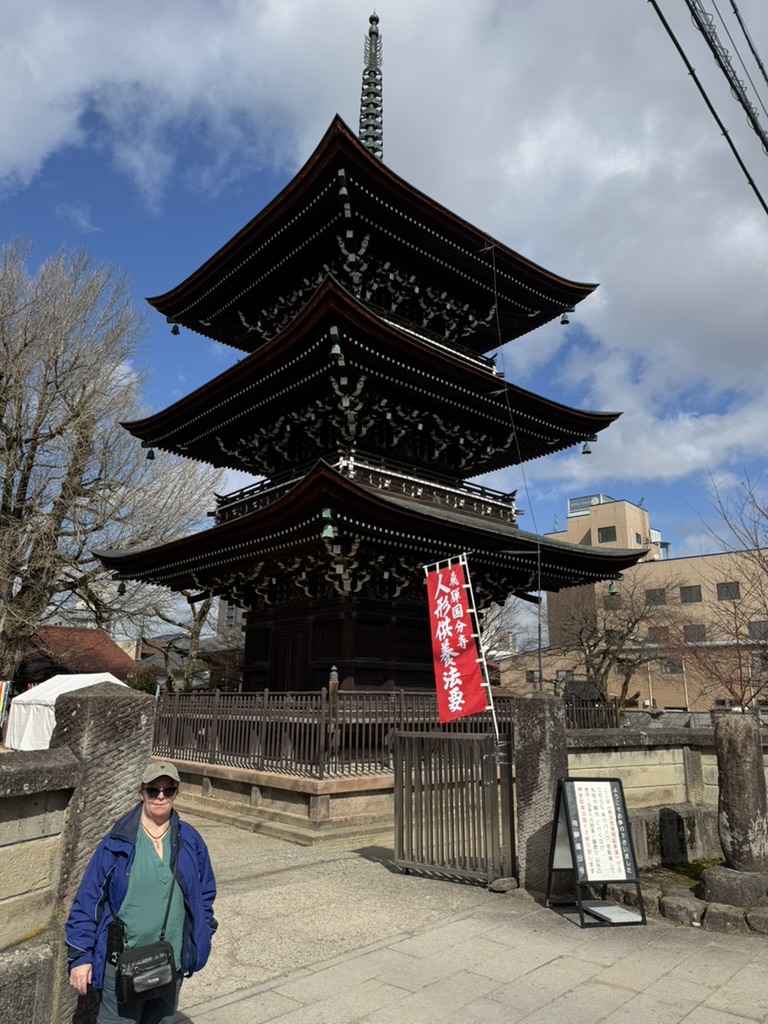
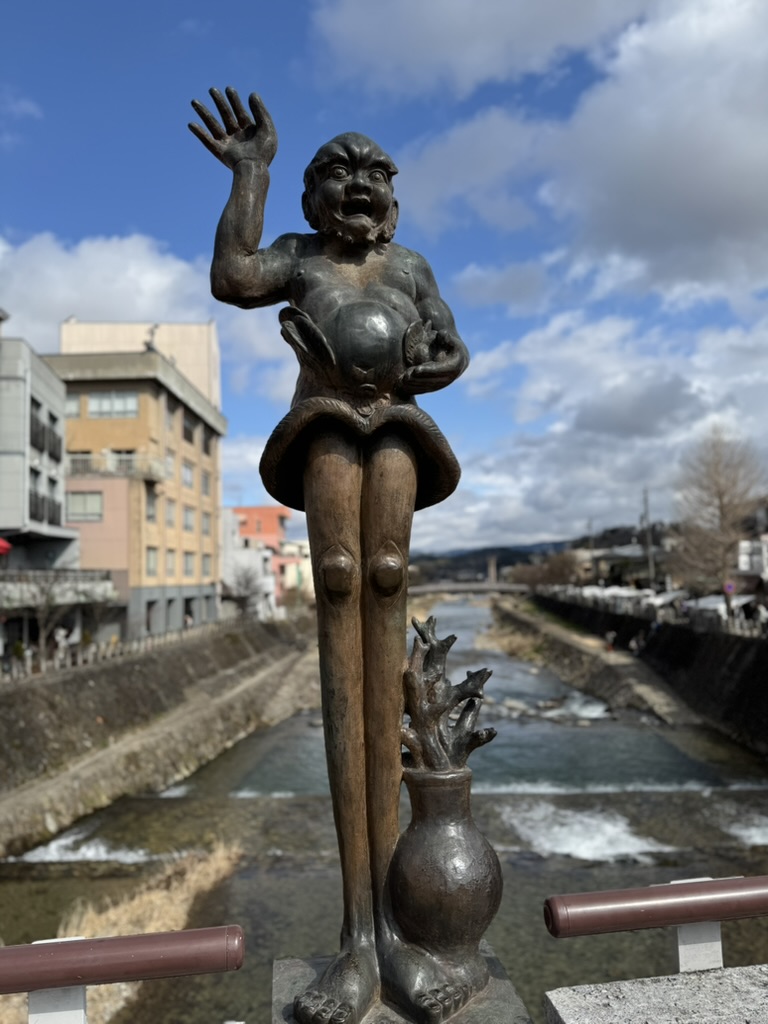
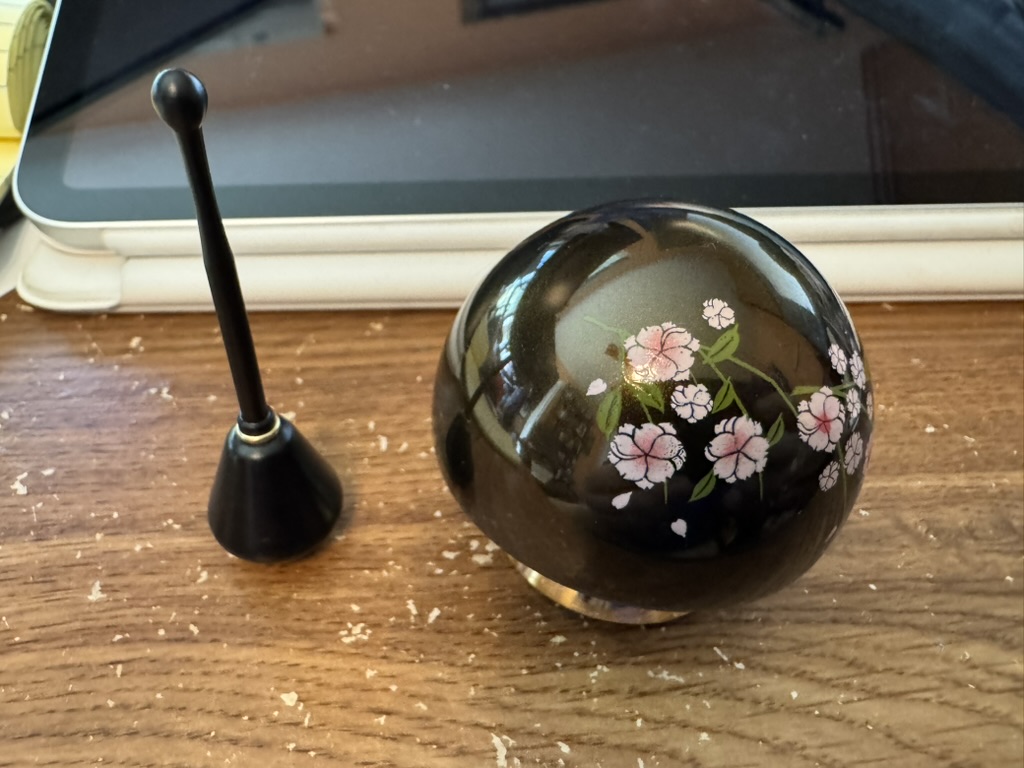
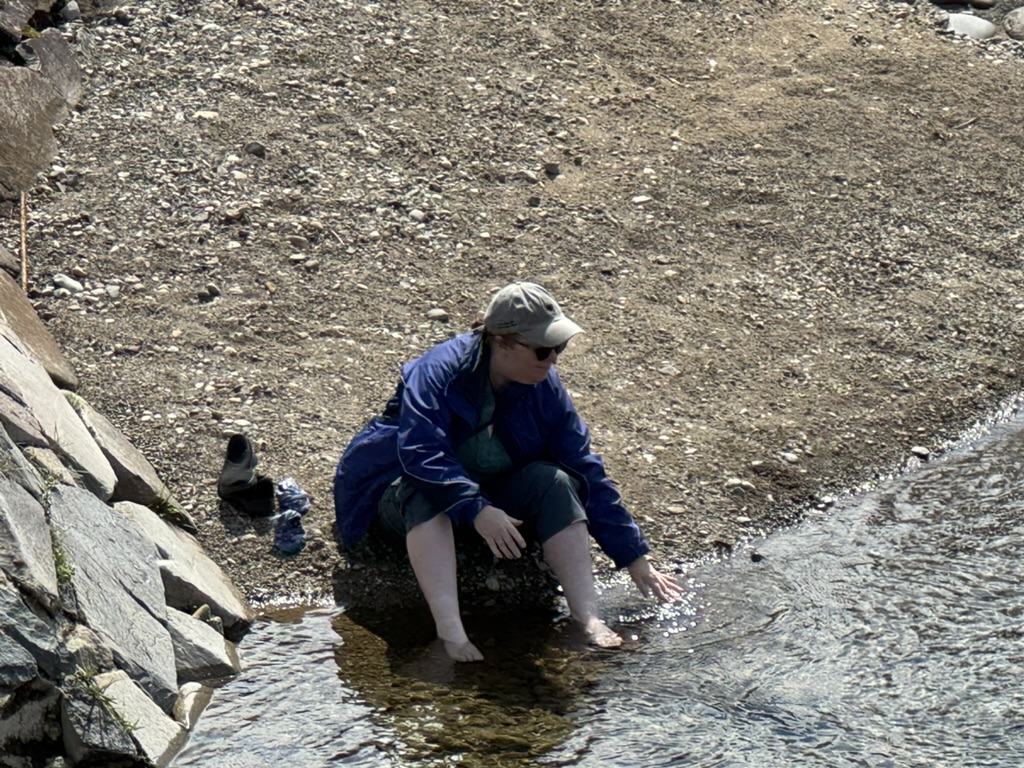
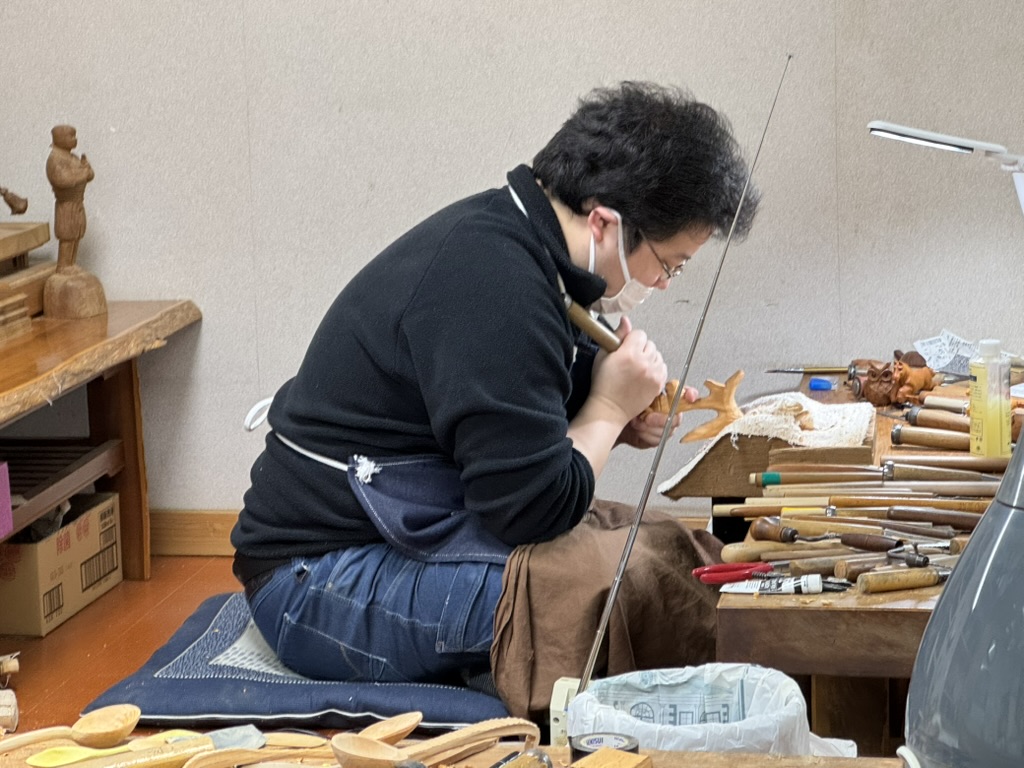

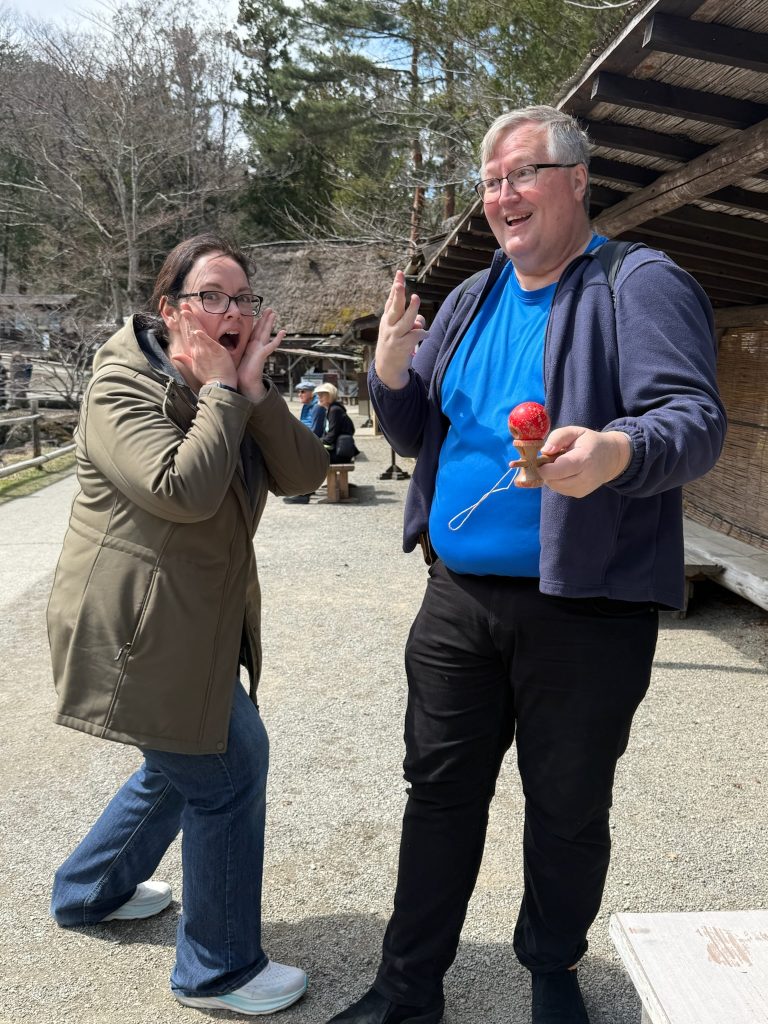
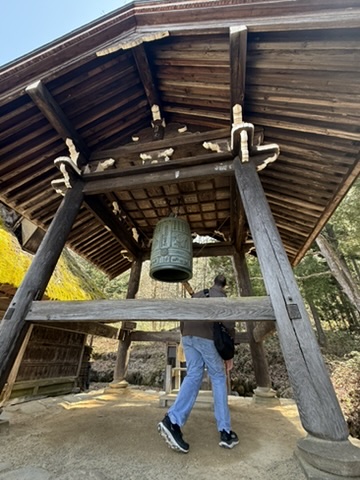
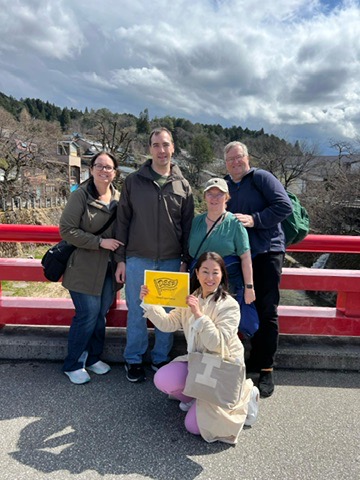
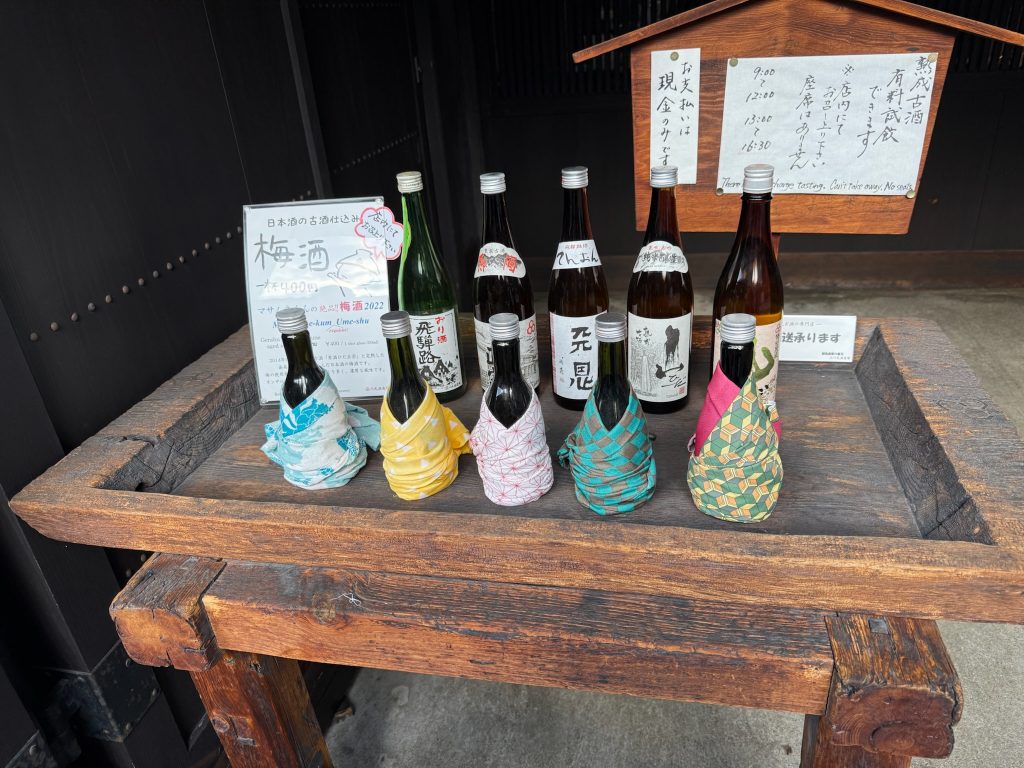
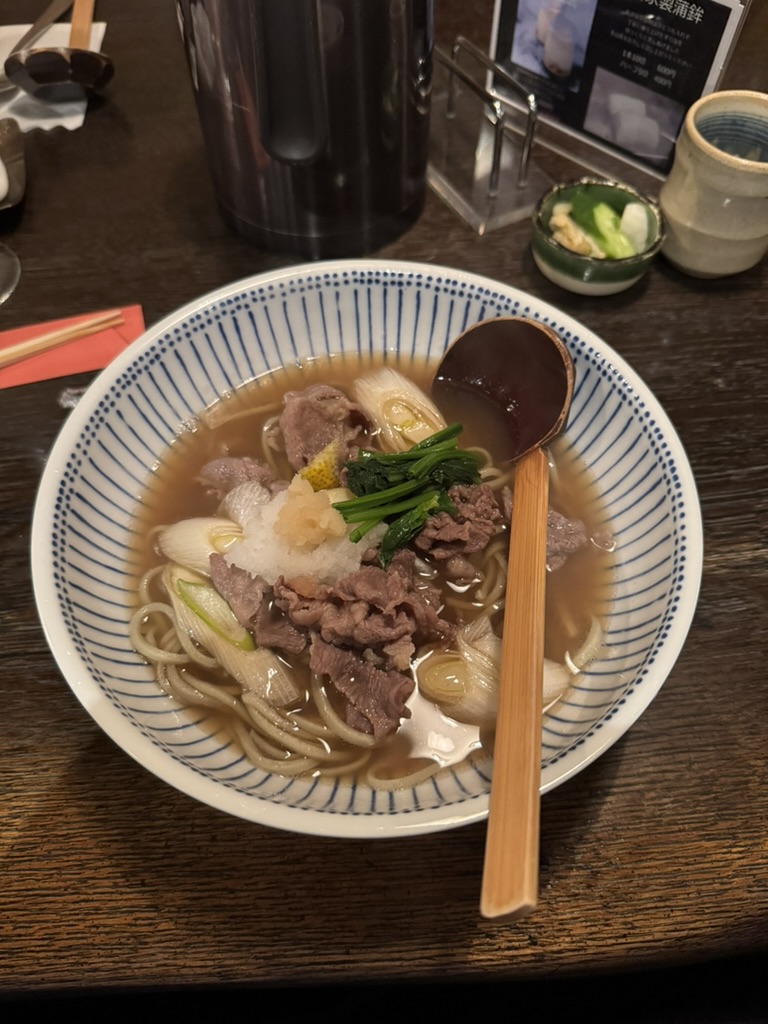
Leaving the hotel, we reached an intersection of major streets where a signpost directed us to the morning market along Kokubun-ji Dori Street. It’s always surprising to discover spectacular sights hidden just around a corner or down an alleyway, previously obscured by buildings or trees. In this case, we glimpsed the side of a three-story pagoda. You still couldn’t see it standing on the sidewalk, but there was a small Torii gate, and as we stepped through into a garden, it seemed to appear suddenly larger than life. Here was the Hida Kokubun-ji Temple. Another little gem we found. Teresa and I took some moments to explore before heading on down to the market.
According to Google maps, the market was on the other side of the river that we were approaching. As we approached the bridge, we noticed two statues midway across. They were facing each other on each side of the street. One had extremely long arms and the other extremely long legs. We found them amusing and said we would find out more later (spoiler, we did).
We crossed the Miyagawa River and found the Morning Market, with stalls lining the riverbank and shops along the road. The stalls offered various foods, snacks, and spices, while the shops featured items like T-shirts, postcards, trinkets, and other souvenirs. As we made our way down the street, one of the stands was selling fish food. Looking closer at the river, it resembled a koi pond, though it was a river filled with large carp, koi, and goldfish. The river itself looked man-made with high walls and very straight lines. I imagine that centuries ago, workers modified the river, straightening it for flood control, as suggested by the high river walls. I also noticed stone breaks every few hundred yards, and upon closer inspection, what appeared to be salmon runs or ladders placed along the edge for fish to swim upstream. We bought a portion of fish food, and made our way down the steps to get closer to the river. It kind of surprised us that unlike the fish in the US getting all excited and fighting over food that when we tossed some of our fish pellets into the water, only a few seemed mildly interested. Perhaps they were well-fed or simply uninterested; it just seemed a bit odd. So we went through a bag of food and were happy to have fed some Japanese fish.
We climbed back up the stairs and I looked up the street and saw Mike and Megan. I knew from our previous days in Osaka and Kyoto, and some of the influencer sites that I follow that it is considered rude to be loud and obnoxious, so even shouting out to Mike and Megan I felt was just wrong. So, I just started walking towards them and waving until they spotted me. The four of us joined up, chatting, shopping, and just enjoying the morning. One shop that I stopped into sold incense, and meditation aids. The incense didn’t have the strong smell I usually find in the US, which was comforting. The thing that caught my eye the most though was a small selection of bells and chimes. They were Buddhist prayer chimes, and I was told that they also aid in warding off evil spirits. Teresa and I looked at each other and smiled. I tried a few of them and found one that I really liked. It’s solid brass and hand painted over the enamel in this case the paintings depicted Sakura, which just seemed fitting. I pointed to it in the shopkeeper found the box for it and its hammer. The cost was somewhere between ¥2000 and ¥3000. I don’t recall, but a ¥2000 that’s only $13 USD.
The four of us continued walking talking (quietly) and shopping. We were coming up on a rather large Torii gate in the shops were getting a little more sparse. I spotted away to get down to the Riverside and wanted to see if it gave me a better perspective or an unusual perspective of the gate. I made my way down, even took a couple pictures of my friends at the top before making my way back up. My friends have been chatting and had lost sight of me and we’re a little confused to see me walking back to them at the top of the street. I explained that the way down wasn’t too bad and once down there, I saw steps leading up on the other side of the bridge. Now Teresa has a life goal if you will of putting your feet into every ocean around the world. It’s not necessarily that we seek these out and it’s not necessarily in the ocean itself, sometimes Teresa uses the transitive function. In this case, we crossed over the ridge of Japan, and the water in this river was not flowing to the Pacific, which she had dipped her feet into several times, but the water heater was flowing to the sea of Japan. And since this was as close, she was gonna get, she made her way down to the river and tipped her feet into the cold water.
So today was one of those days that Mike and Megan had booked the tour for the four of us and it was getting close to the time where we were supposed to meet our guide. So we gathered up and started making our way back up towards the meeting place. There are more shops open on the way up and one of them caught her eye as the window was adorned with wood carvings. We stepped inside and looked at the marvelous sculptures and carvings. We found a couple carvings that we liked. Of course we had to take into account, size, shape, weight, and even delicacy. The shop had signs in several places stating no photography, and we honored that. When we got to the counter to pay for the couple pieces, I noticed the artisan in the back working on something. I pulled out my phone and opened Google translate to make sure that my message or question was clear. I asked the lady working the counter if it was OK for me to take a picture of the art and working, not of any of the finished works that were in the shop, but just him working on a piece there in the back. She looked at me twice and said it would be OK. In the current days of machine, milling and CNC types of product production in mass quantities, is refreshing to see an artisan working on his craft.
So, as we’re walking to the meeting site, we are chatting about the upcoming tour. It was to be a walking tour finished by a tour of the sake breweries. Mike had said that the original tour had been canceled, and that the tour company found another guide, who also canceled. They say that the third time is a charm, but the third one canceled as well. So they reached out to another tour company and as of this point, we were still on.
We got to the meeting point where we met with Mihoko of Deep Experience Tours. She said she had a lovely itinerary laid out for the four hours that she would be guiding us around. She said that we’re gonna take with the first stop being the morning market. We smiled, maybe even chuckled, and saw some confusion on her face. We explained that we’ve already been to the morning market. Her confusion cleared a little and she pivoted for lack of a better term and suggested we make our way up to the Hida Village. She asked if we would be comfortable walking and we assured her that we would, but we’ve been walking through throughout Osaka and Kyoto. It was quite a walk as we started climbing the hills, I found that I needed to stop a little. The five of us chatted along the way; she was getting to know us, we are getting to know her, and she was importing tidbits of knowledge of the area.
We finally arrived at Hida Minzoku Mura Folk Village, an open air museum showing off the traditional architecture styles found in the mountainous regions of Japan. She went into the history of the thatching of the roofs. As we made it around to several of the buildings, she pointed out the thickness and structure that hold the weight of these roofs. She explained different features in the different size homes, pointing out the cooking spaces, the living spaces, the sleeping spaces, spiritual spaces, and more. She explained that many of the homes were multigenerational. Many of the families would work the Rice fields, or the batching, or even the raising of silkworms. One exhibit showed a collection of dolls, and she went on to explain about Hinamatsuri or Doll’s Day. Dolls were handed down from generation to generation, each Doll representing the emperor, empress, attendants, musicians, and other courtly figures.
Mihoko also took us to see a large temple bell. She said that a person who rings the bell and asks for favor that whatever is asked upon within the echo of the bell will be granted. We enjoyed the grounds and Mihoko was a wealth of information, but it did not stop there.
Our tour was also to include the Sake Breweries, and there were several in the market place back in Takayama. To save time, we took taxis back. We stopped a few blocks away near the government center. Here Mihoko told us of the history of the government, the city planning and such as we made our way to the bridge. She also told us we would be missing the “Takayama Spring Festival”, a very big festival with floats, music, and dance performances from famous entertainers from across the country. We stopped, on the bridge where Mihoko imparted the story of the statues.
In Takayama, Japan, the Kajibashi Bridge over the Miyagawa River features two distinctive bronze statues representing characters from Japanese folklore: Ashinaga (Long Legs) and Tenaga (Long Arms). These figures are part of a traditional tale where they collaborate to fish—Ashinaga wades into the water with his long legs, carrying Tenaga on his back, who then uses his extended arms to catch fish. This story emphasizes the value of cooperation and combining individual strengths to achieve a common goal.
It is a value she shares, and so do we. We made our way into the market place. She showed us to a few shops where we shared for food, treats, and of course Sake. She explained the breweries can always be identified by a large brown ball if straw hanging above the door. The ball, or “Shimekake”, is said to represent the purity and sanctity of the Sake inside.
So at one brewery, they had a vending machine for Sake cups, just ¥200 per cup. You would use these cups in their sake dispensers. You then go to another vending machine where you would buy that brew coins. The Sake dispensers would take one of those coins to any one of the Sake dispensers and you then press the button and it would dispense out sake directly from a chilled or heated bottle inside that machine to your cup. Each sample cup might hold between 30–60 ml, as compared to a US shot being around 44 ml. And Sake has alcohol by volume (ABV) of about 15-20% where as say a US Whiskey might be 40-50% ABV. Most of the breweries we stopped in sold us 10 coins.
Our time was up with Mihoko and she left our group after the second brewery. I cannot tell you how much she imparted on us, but I can tell you that she made us feel at home with her. She was a wonderful tour guide and if you ever get to Takayama or that area, call on Deep Experience Tours and ask for Mihoko.
After she left us, I don’t recall if we did two or three more breweries, but I was definitely feeling it in the end. During that time, Mihoko actually texted us and told of restaurant she would recommend, Miyabi-Soba, which had a vegetarian Ramen.
I am going to add a note here, a warning if you will. I found this out after I got home and should have learned my lesson the first time. If you do find something you like, don’t buy just one. Many years ago while touring the UK, I found this liqueur in Scotland called “Mrs Walker’s Drumgray Highland Cream”. It is bottled in Scotland by Burn Stewart Distillers. Drumgray is a wonderfully decadent blend of the finest fresh cream and aged Deanston Single Malt Scotch Whisky, masterfully combined to capture the “essence of the Highlands”. It has a taste of chocolate, cream, and butterscotch. It is also nearly impossible to find the US. When you do find it, it is marked up AND you have to pay more for shipping. Needless to say, I don’t get it often.
What does this have to do with our Japan? Well, I purchased a bottle of Yuzu Sake, just a single bottle, with the thought that it would be available in the US. So far, I’ve not been able to find a source. I still have my bottle, unopened, and I took pictures of the box and used Google Translate to make sure I’m asking the wines shops and liquor stores around here for the same thing.
I’ll keep looking though. This may be my Japanese “Drumgray” (or “Maui Blush” – A pineapple wine from Maui).
